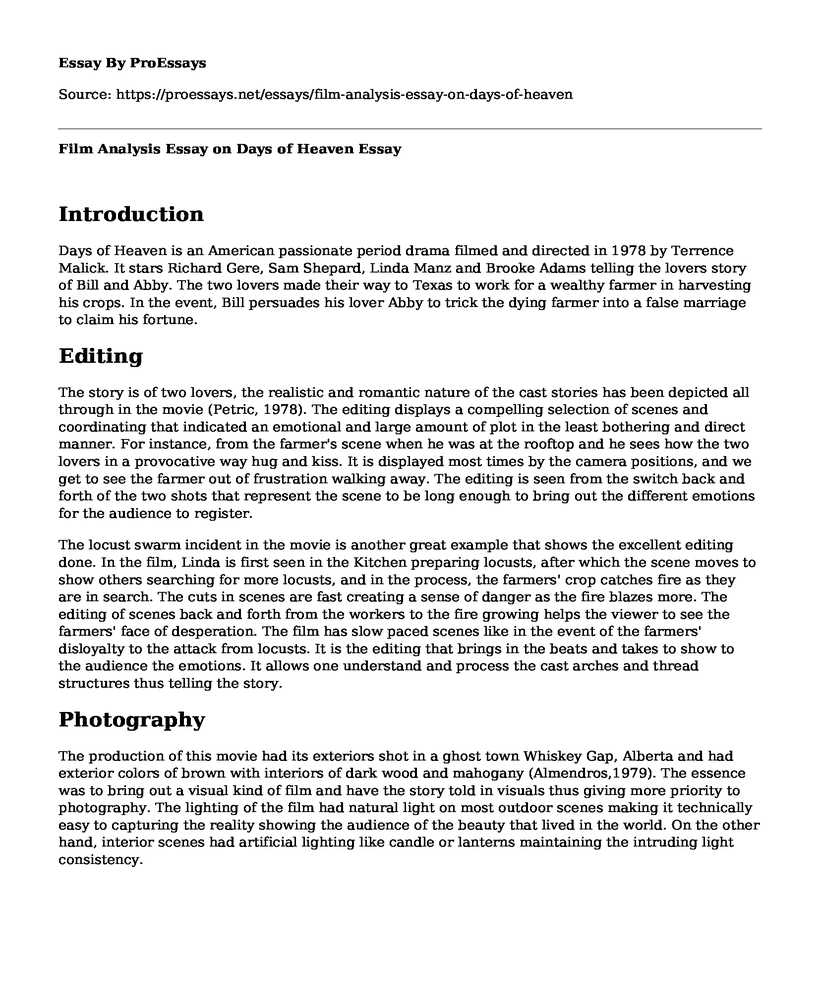Introduction
Days of Heaven is an American passionate period drama filmed and directed in 1978 by Terrence Malick. It stars Richard Gere, Sam Shepard, Linda Manz and Brooke Adams telling the lovers story of Bill and Abby. The two lovers made their way to Texas to work for a wealthy farmer in harvesting his crops. In the event, Bill persuades his lover Abby to trick the dying farmer into a false marriage to claim his fortune.
Editing
The story is of two lovers, the realistic and romantic nature of the cast stories has been depicted all through in the movie (Petric, 1978). The editing displays a compelling selection of scenes and coordinating that indicated an emotional and large amount of plot in the least bothering and direct manner. For instance, from the farmer's scene when he was at the rooftop and he sees how the two lovers in a provocative way hug and kiss. It is displayed most times by the camera positions, and we get to see the farmer out of frustration walking away. The editing is seen from the switch back and forth of the two shots that represent the scene to be long enough to bring out the different emotions for the audience to register.
The locust swarm incident in the movie is another great example that shows the excellent editing done. In the film, Linda is first seen in the Kitchen preparing locusts, after which the scene moves to show others searching for more locusts, and in the process, the farmers' crop catches fire as they are in search. The cuts in scenes are fast creating a sense of danger as the fire blazes more. The editing of scenes back and forth from the workers to the fire growing helps the viewer to see the farmers' face of desperation. The film has slow paced scenes like in the event of the farmers' disloyalty to the attack from locusts. It is the editing that brings in the beats and takes to show to the audience the emotions. It allows one understand and process the cast arches and thread structures thus telling the story.
Photography
The production of this movie had its exteriors shot in a ghost town Whiskey Gap, Alberta and had exterior colors of brown with interiors of dark wood and mahogany (Almendros,1979). The essence was to bring out a visual kind of film and have the story told in visuals thus giving more priority to photography. The lighting of the film had natural light on most outdoor scenes making it technically easy to capturing the reality showing the audience of the beauty that lived in the world. On the other hand, interior scenes had artificial lighting like candle or lanterns maintaining the intruding light consistency.
References
Dominik, A., Hansen, R., Pitt, B., Affleck, C., Shepard, S., Parker, M. L., ... & Rockwell, S. (2007). The assassination of Jesse James by the coward Robert Ford. Warner Bros. Entertainment.
Almendros, N. (1979). Photographing Days of Heaven. American Cinematographer, 60(6), 562-630.
Petric, V. (1978). Days of Heaven. Film Quarterly (ARCHIVE), 32(2), 37.
Cite this page
Film Analysis Essay on Days of Heaven. (2022, Nov 24). Retrieved from https://proessays.net/essays/film-analysis-essay-on-days-of-heaven
If you are the original author of this essay and no longer wish to have it published on the ProEssays website, please click below to request its removal:
- Bulworth Film Analysis Essay
- Pop Culture Essay on Beyonce the Singer
- Film Analysis Essay on Vice: Narrative Time, Space, Causality and Change
- Research Paper on Gorgeous Persian Fashion: Iran's Unique Style Flair
- Movie Analysis Essay on No Country for Old Men by Joel and Ethan Coen
- Book vs Film: The Debate Over Adaptations Continues - Essay Sample
- Paper Example on Adaptations: A Comprehensive Anthology of Short Stories and Films







